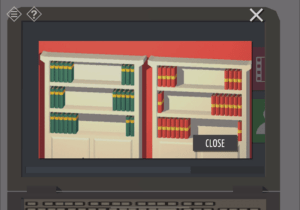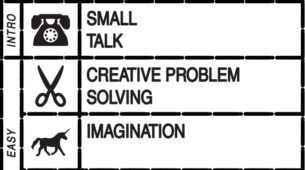Tiny Room Story: Town Mystery, a mobile puzzle game developed by Kiary Games for iOS and Android, is designed for players who enjoy slow-paced, logic-based mysteries. The game tells its story through its environments, using rotating 3D spaces and hidden objects to gradually reveal a larger narrative. Its architecture sets the scene and shapes the way the story unfolds, making the space a key storytelling tool.


Each level in Tiny Room Story is essentially a room of small building that the player can rotate and zoom into. While the interface feels clean and toy-like, each room contains hidden keys, drawers, safes, and switches. These physical puzzles are embedded into the architecture. The player uncovers story fragments as they solve these puzzles, like a passcode inspired by the oven patterns (see Figure 1) or a bookcase pattern to unlock a door (see Figure 2). The act of solving these environmental riddles parallels the protagonist’s search for answers about their missing father and the deserted town.
Compared to similar mobile puzzle games like The Room or Monument Valley, Tiny Room Story leans more into realism and plot. It doesn’t just create surreal environments to explore. Instead, it grounds each room in narrative logic, using props and placement to hint at what happened. For example, a randomly closed off road and a locked window communicates abandonment and secrecy before any words are shown (see Figure 3). This is an excellent example of environmental storytelling that doesn’t rely solely on text, but the image and scene of the game itself.

According to Jenkins’ framework, Tiny Room Story functions as both an embedded narrative and an enacted environment. Story clues are hidden in spaces the player must explore in a deliberate order, and meaning emerges gradually as each puzzle is solved. The game becomes a point-and-click mystery disguised as an architectural logic box where each new space unfolds new parts of the narrative.
Framed through the MDA framework, the mechanics include point-and-click movement, 3D room rotation, and interactive object puzzles. These mechanics create dynamics that emphasize exploration, spatial reasoning, and discovery. The player learns to pay close attention to objects, angles, and environmental cues. These dynamics lead to the aesthetic experience of Discovery, one of the core types of fun described by LeBlanc. The thrill of uncovering hidden drawers and accessing new rooms taps into a slow-burning, curiosity-driven form of engagement.
In addition to Discovery, the game also employs Narrative fun, as the player pieces together fragments of the protagonist’s backstory and the mystery surrounding the deserted town. However, the emotional payoff is occasionally limited by puzzles that feel abstract or unrelated to the story’s stakes. Integrating more emotionally resonant puzzles, such as artifacts, memories, or relationships, would enhance both the narrative arc and the feeling of meaningful progress.
The game’s architectural design mirrors the protagonist’s emotional state: locked out, searching for clarity, and forced to move slowly through literal and metaphorical barriers. This aligns with the concept of narrative architecture as described in The Role of Architecture in Game Design, where spatial constraints and guided access become metaphors for inner transformation. The rotating camera mechanic adds to this, reinforcing the idea that players must actively search and shift their perspective to uncover truth — they are never given the whole picture at once.

One notable accessibility challenge is the game’s reliance on visual perception and fine motor interactions. Because clues are often embedded in small, detailed areas (like drawer corners or color-coded locks), players with low vision or motor impairments may struggle (see Figure 4). The game does not include adjustable contrast or screen reader compatibility, which limits access for a wider audience. For a puzzle game grounded in careful observation, the lack of inclusive design tools is a major limitation.
Ultimately, Tiny Room Story creates an elegant loop between space, mystery, and player action. But when puzzles lose narrative grounding or when ad-based mechanics interrupt immersion, the emotional resonance is weakened. By aligning mechanics more tightly with the protagonist’s emotional journey, the game could deliver a more cohesive and impactful experience.


